Tyrannosaurus was one of the largest of the "lizard-hipped" carnivorous dinosaurs known as theropods. It was a massive two legged with a powerful tail, large head and tiny arms from the late cretaceous.
Its primary weapon was its mouth, with a 1.2 metre long jaw and a 1 metre gape. Curved serrated teeth, longer than a human hand, could be used to puncture an animal's organs, before Tyrannosaurus tore the flesh off. Tyrannosaurus could not chew, so had to swallow its food whole. It could probably gulp up to 70 kilograms in one go. One fossil shows the danger of this - a large carnivore had died swallowing, with two long bones stuck in its gullet.
In the picture above it is attacking the armored dinosaur Edmontonia and in the following one you can spot a flying Quetzalcoatlus and Pleurocoleus as well.
Its tiny two-fingered arms seemed very small, but were believed to have been at least three times as strong as human arms. They were too short to reach its mouth, but were probably used as meat-hooks. There is clear evidence that tyrannosaurs fought one another from tooth-marks left in fossil remains.
The first reasonably complete Tyrannosaurus skeleton was discovered by palaeontologist Barnum Brown in Hell Creek, Montana, in the USA in 1902. Until this find only fragments had been unearthed. In all, over 20 individuals have been found, although, only three have complete skulls. Remains have been discovered from Alberta and Saskatchewan in Canada,to New Mexico, Montana, Texas, Utah, and Wyoming in the USA. Remains have also been found in Mongolia.
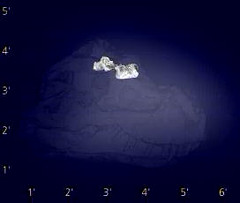
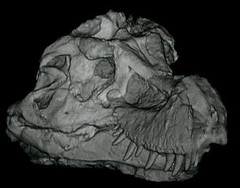
Its primary weapon was its mouth, with a 1.2 metre long jaw and a 1 metre gape. Curved serrated teeth, longer than a human hand, could be used to puncture an animal's organs, before Tyrannosaurus tore the flesh off. Tyrannosaurus could not chew, so had to swallow its food whole. It could probably gulp up to 70 kilograms in one go. One fossil shows the danger of this - a large carnivore had died swallowing, with two long bones stuck in its gullet.
In the picture above it is attacking the armored dinosaur Edmontonia and in the following one you can spot a flying Quetzalcoatlus and Pleurocoleus as well.
Its tiny two-fingered arms seemed very small, but were believed to have been at least three times as strong as human arms. They were too short to reach its mouth, but were probably used as meat-hooks. There is clear evidence that tyrannosaurs fought one another from tooth-marks left in fossil remains.
The first reasonably complete Tyrannosaurus skeleton was discovered by palaeontologist Barnum Brown in Hell Creek, Montana, in the USA in 1902. Until this find only fragments had been unearthed. In all, over 20 individuals have been found, although, only three have complete skulls. Remains have been discovered from Alberta and Saskatchewan in Canada,to New Mexico, Montana, Texas, Utah, and Wyoming in the USA. Remains have also been found in Mongolia.
But not everything were those remains... Jeff Anders and Tom Koehnlein did it—a CT scan of a Tyrannosaurus rex skull. The 2,000-pound (908-kilogram) head belonging to Sue, the largest and most complete T. rex ever found, would never fit on an ordinary medical scanner. So Sue went to a Boeing lab in California, where the two engineers spent some 500 hours in 1998 x-raying coin-thin portions of the skull—slicing digitally instead of destructively. “We’d never done anything like it before,” said Koehnlein. The result: new insight into Sue’s senses.


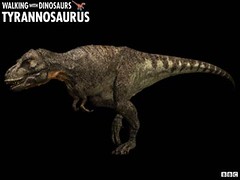
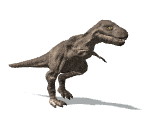
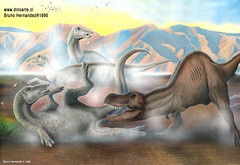
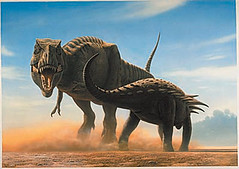
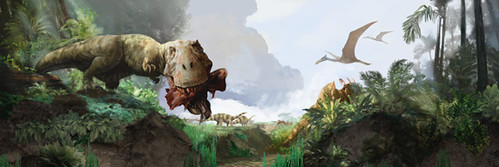
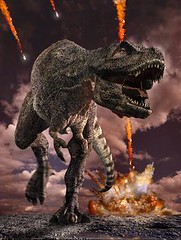
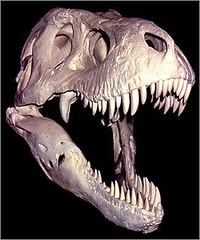
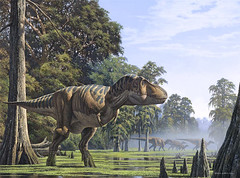

No hay comentarios.:
Publicar un comentario
¡Comenta ya!
Send your Owler or Howler!
***
Si no quieres responder con tu cuenta google o wordpress o etc, puedes escoger poner tu nombre con la opción Nombre/URL.